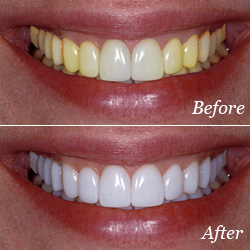Teeth Whitening

Everybody loves a bright, white smile. And with a variety of teeth whitening options available to you, you can begin to feel more comfortable and confident about smiling.
Many people are satisfied with the sparkle they get from brushing twice daily with fluoride toothpaste, flossing once a day, and regular cleanings at the dentist's office. However, if you decide you would like to go beyond regular care to make your smile look brighter, you should investigate all of your options.
Finding the Best Treatment for You
Schedule a visit with our dentist to learn whether whitening procedures would be effective for you. Whiteners do not correct all types of discoloration. For example, yellowish teeth will probably bleach well, brownish teeth may bleach less well, and grayish teeth may not bleach well at all. Likewise, whitening may not enhance your smile if you have had tooth-colored fillings or crowns. The whitener will not affect the color of these materials and they will stand out in your newly whitened smile. In these cases, you do have other options, such as porcelain veneers.
Tooth Whitening Treatments
- Professional teeth whitening with your doctor
- At-home whitening system
- Whitening toothpaste
When selecting a whitener or any dental product, be sure to look for the ADA Seal of Acceptance — your assurance that a product has met ADA standards of safety and effectiveness.
 Professional Teeth Whitening
Professional Teeth Whitening
Professional teeth whitening by Dr. Little and Rajaski is your best choice when you need immediate whitening results. This procedure is called chair-side bleaching and may require more than one office visit. Each visit may take from sixty to ninety minutes.
During chair-side bleaching, Dr. Little and Rajaski will apply either a protective gel to your gums or a rubber shield to protect the oral soft tissues. A bleaching agent is then applied to the teeth and a special light may be used to enhance the action of the agent.
At-Home Whitening System
There are several types of products available for use at home, which can either be dispensed by Dr. Little and Rajaski or purchased over the counter. They are generally teeth whitening trays (mouthguards), strips, or paint-on products.
Teeth Whitening Trays
These products contain peroxide(s) which actually bleach the tooth enamel. Carbamide peroxide is the bleaching agent and comes in several different concentrations (10%, 16%, and 22%). Peroxide-containing whiteners typically come in a gel and are placed in a mouthguard. Usage regimens vary. Some products are used twice a day for 2 weeks, while others are intended for overnight use for 1-2 weeks. If you obtain the bleaching solution from our office, we can make a custom-fitted mouthguard for you that will fit your teeth precisely. Currently, only dentist-dispensed, home-use, 10% carbamide peroxide tray-applied gels carry the ADA Seal.
Teeth Whitening Strips
Teeth whitening strips are thin, flexible plastic (polyethylene) strips with a thin film of hydrogen peroxide bleaching on one side. Whitening strip kits come with two types of strips: strips for the upper teeth and strips for the lower teeth. The bleaching agent is applied by placing the strips across your teeth and gently pressing the strips into place to insure contact with all your teeth. Teeth whitening strips are typically worn for 30 minutes a day, twice a day. The duration of treatment will vary.
Paint-On Teeth Whitening
Paint-on teeth whitening allows you to apply a bleaching agent directly to your teeth without an appliance or strip. You simply "paint" the whitener onto the surface of clean, dry teeth and wait about 30 minutes while the paint turns to a dry film. To remove this film, you simply brush your teeth with a toothbrush. Paint-on whitening products require twice-daily applications to be effective. The duration of treatment will vary. An advantage in this process is that you can selectively paint individual teeth.
Teeth whitening can have minor side-effects and you should speak with Drs. Little and Rajaski if these become bothersome. For example, teeth can become sensitive during the period when you are using the bleaching solution. In most cases, this sensitivity is temporary and should lessen once the treatment is finished. Some people also experience soft tissue irritation, either from a tray that doesn't fit properly or from solution that may come in contact with the tissues. If you have concerns about such side effects, you should discuss them with Drs. Little and Rajaski.
Whitening Toothpaste
All toothpastes help remove surface stain from your teeth through the action of mild abrasives. "Whitening" toothpastes in the ADA Seal of Acceptance program have special chemical or polishing agents that provide additional stain removal effectiveness. Unlike bleaches, these ADA Accepted products do not alter the intrinsic color of teeth.
